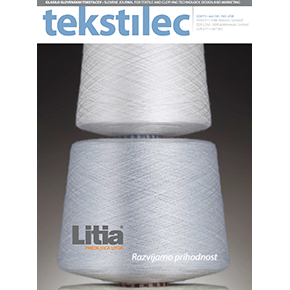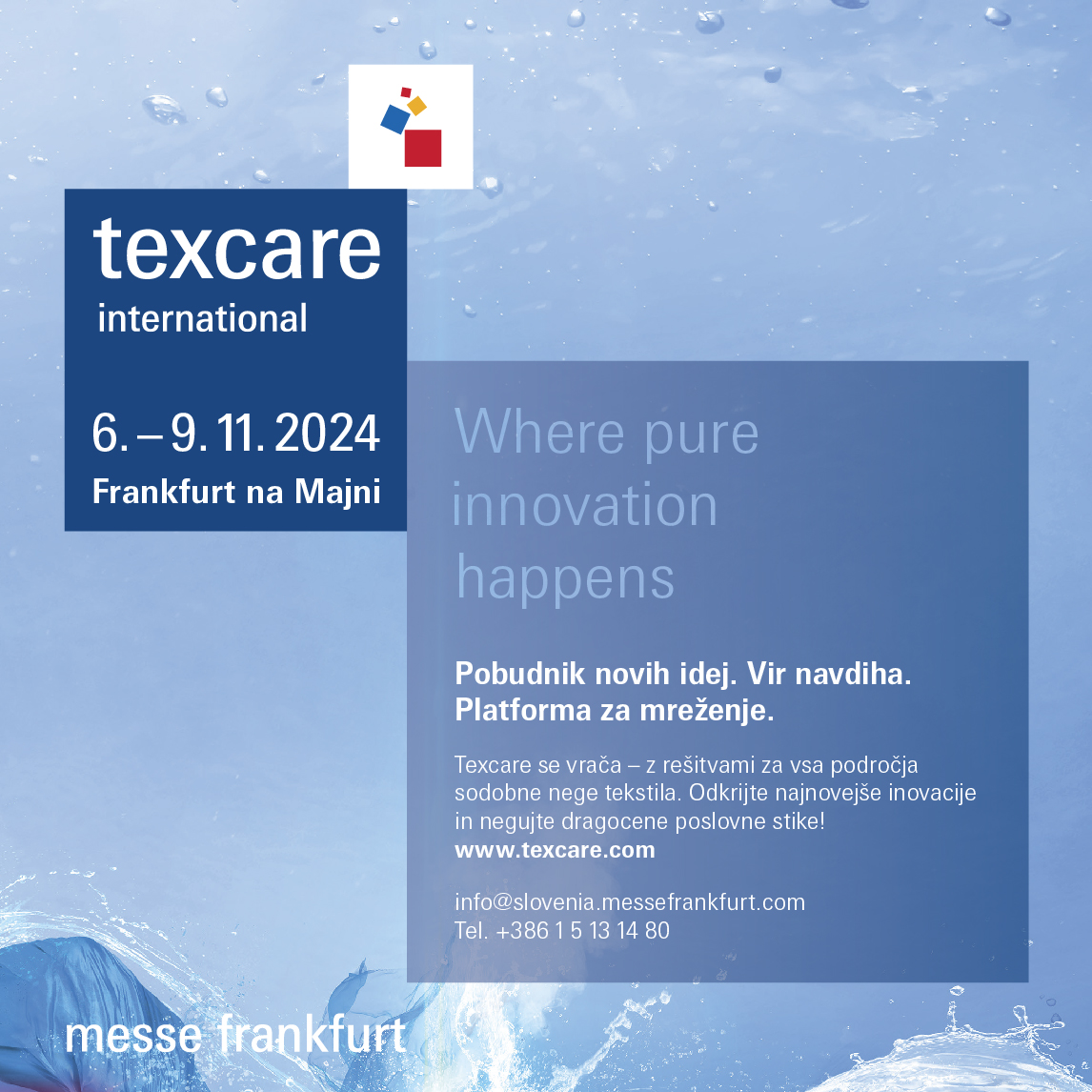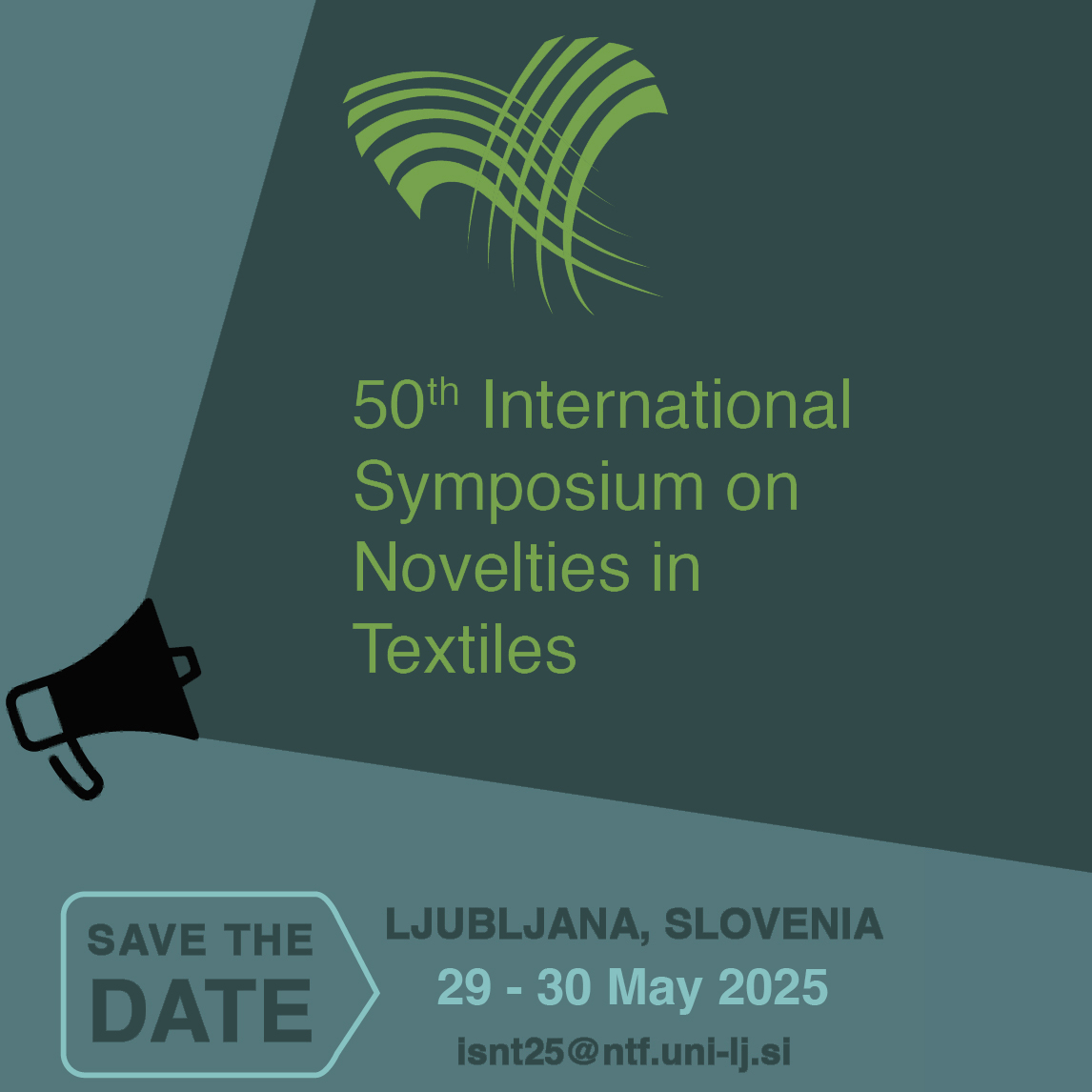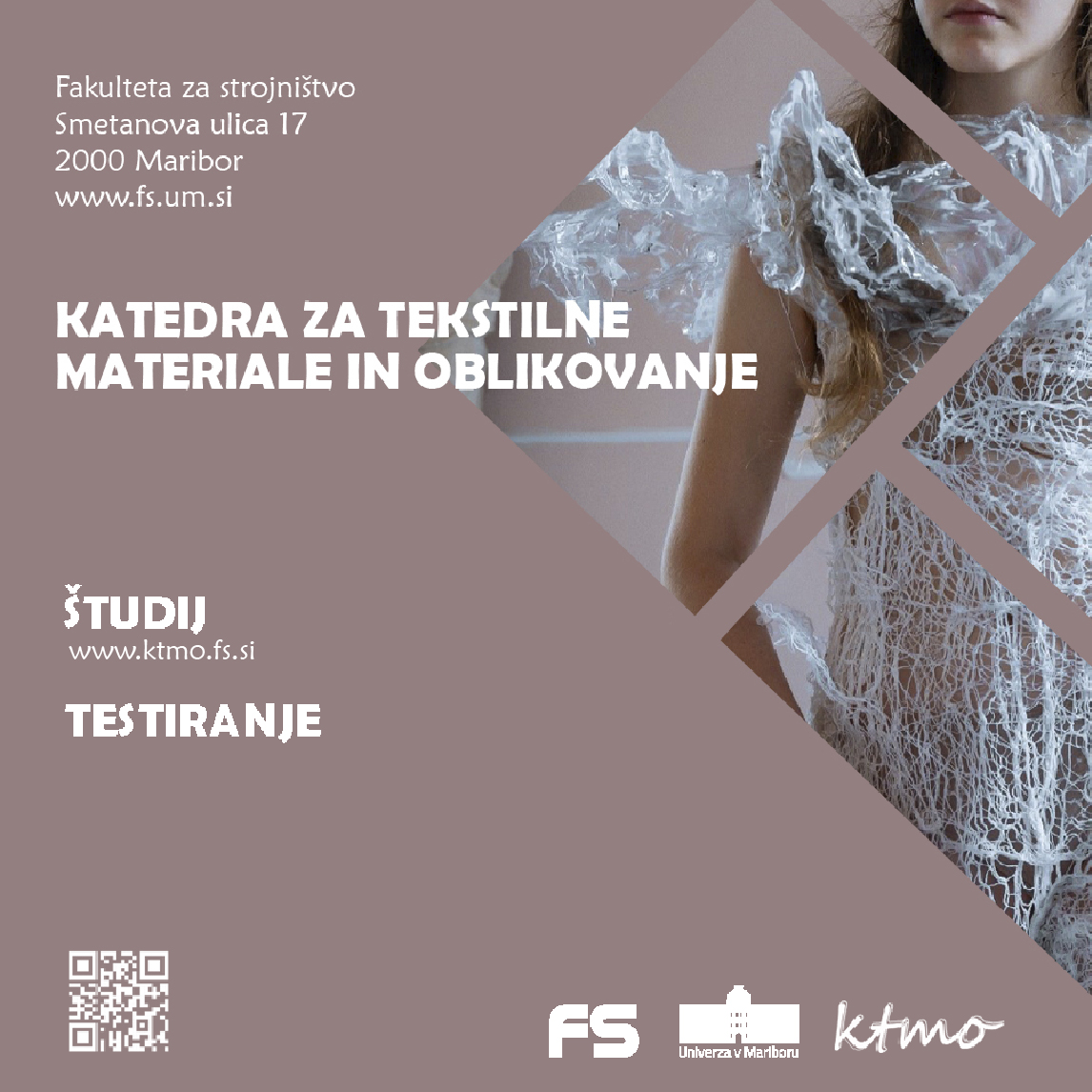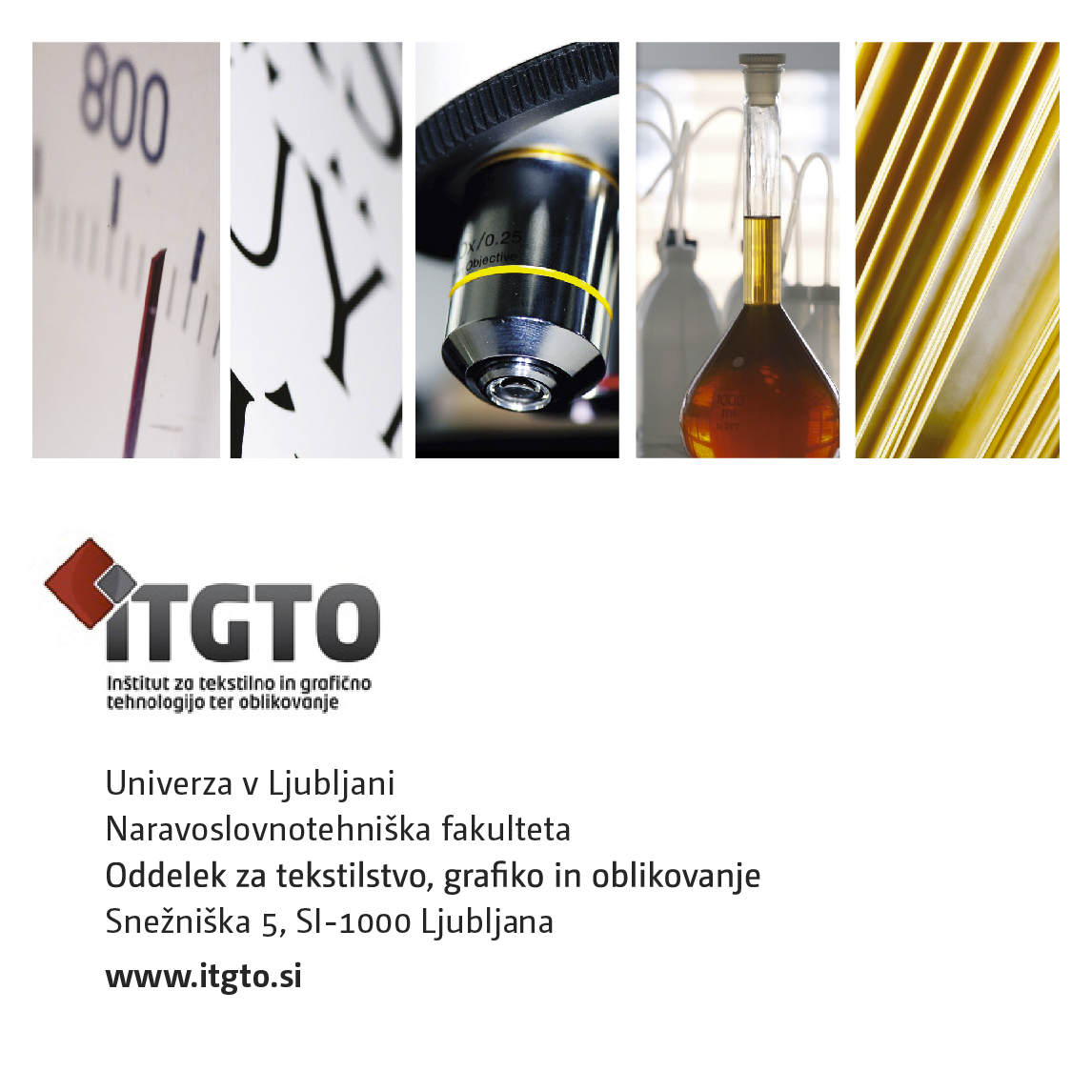Tekstilec, Vol. 58, 2015(3)
CONTENTS
SCIENTIFIC ARTICLES
168 New Approach for Optimising the Impregnations of Individual Batches of Aramid Fabrics
………..Natalja Fjodorova*, Marjana Novič*, Tamara Diankova**, Olga Baskova** Abstract and References
*National Institute of Chemistry, Laboratory of Chemometrics, Hajdrihova 19, SI-1000 Ljubljana
**St. Petersburg State University of Technology and Design, Department of Chemical Engineering and Textile Design, Bolshaya Morskaya Str. 18, RU-191186, St. Petersburg, Russia
Original Scientific Article
Received 04-2015 • Accepted 07-2015
Corresponding author:
D.Sc. Natalja Fjodorova
Phone: +386 1 4760441
E-mail: natalja.fjodorova@ki.si
Abstract
Innovate textile materials for special clothing are intended for providing trauma protection for the wearer. Fabrics made from high performance aramid fibres are widely used nowadays for manufacturing athletic sportswear for extreme sports due to their high specific tensile modulus and strength. The aim of our study was to illustrate a new approach when searching for optimal settings for impregnating individual batches of textile materials on the basis of para aramid fibres. We demonstrate a feed-forward bottleneck (FFBN) neural network mapping technique that makes it possible to see all optima (optimal settings for best quality) in the studied process. The selections of optimal settings are based on making decisions allowing us to choose optimal settings for processes in relation to the best quality and smallest (minimal) expense. This new approach can be applied for searching optimal settings regarding different chemical treatments. If a standard statistical regression model (in the cases of non-linear relationships) experiences lack of fit, it can be successfully substituted with the FFBN neural network mapping technique. This method can also be recommended as a double check of a studied process when we use other approaches.
Keywords: aramid fabrics, optimisation, impregnation, feed-forward bottleneck neural network, design of experiment
References
- Alchemie Group home page [online], [accessed 22. 4. 2015]. Available on Word Wide Web: <http://alchemie-group.com/core-materials-technology/autx-aramid-fibre/compliance/>.
- KIM, Hyun Ah and KIM, Seung Jin. Physical properties of para-aramid/nylon hybrid air textured yarns for protective clothing. Fibers and Polymers, 2014, 15(11), 2428–2436, doi: 10.1007/s12221-014-2428-5.
- ZHENG, Huanda and ZHENG, Laijiu. Dyeing of meta-aramid fibers with disperse dyes in supercritical carbon dioxide. Fibers and Polymers, 2014, 15(8), 1627–1634, doi: 10.1007/s12221-014-1627-4.
- BILISIK, Kadir. Experimental determination of yarn pull-out properties of para-aramid (Kevlar®) woven fabric. Journal of Industrial Textiles January, 2012 41(3), 201–221, doi: 10.1177/1528083711413411.
- UPPAL, Rohit, RAMASWAMY, Gita N. and LOUGHIN, Thomas. A novel method to assess degree of crystallinity of aramid filament yarns. Journal of Industrial Textiles, 2013, 43(1), 3–19, doi: 10.1177/1528083712444648.
- LIN, Lantian, SHEN, Yiping and ZHANG, Qiuping. Analysis of environmental impact on mechanical properties of aramid filaments. Journal of Industrial Textiles, 2013, 42(4), 489–500, doi: 10.1177/1528083712446383.
- PARK, Jong Lyoul, YOON, Byung Il, PAIK, Jong Gyu and KANG, Tae Jin. Ballistic performance of p-aramid fabrics impregnated with shear thickening fluid. Part I – Effect of laminating sequence. Textile Research Journal, 2011, 82(6), 527–541, doi: 10.1177/0040517511420753.
- ZIELINSKA, Dorota, DELCZYK-OLEJNICZAK, Bogumila, WIERZBICKI, Lukasz, WILBIK-HAŁGAS, Bożena, STRUSZCZYK, Marcin Henryk and LEONOWICZ, Marcin. Investigation of the effect of para-aramid fabric impregnation with shear thickening fluid on quasi-static stab resistance. Textile Research Journal, 2014, 84 (15), 1569–1577, doi:10.1177/0040517514525881.
- LI, Ting-Ting, WANG, Rui, LOU, Ching Wen and LIN, Jia-Horng. Evaluation of high-modulus, puncture-resistance composite nonwoven fabrics by response surface methodology. Journal of Industrial Textiles, 2013, 43(2), 247–263, doi: 10.1177/1528083712452900.
- ZHIYING, Cui, YANMIN, Wan and WEIYUAN, Zhang. Thermal protective performance and moisture transmission of firefighter protective clothing based on orthogonal design. Journal of Industrial Textiles, 2010, 39(4), 347–356, doi: 10.1177/1528083709347126.
- LEE, Kyulin and CHO, Gilsoo. The optimum coating condition by response surface methodology for maximizing vapor-permeable water resistance and minimizing frictional sound of combat uniform fabric. Textile Research Journal, 2014, 84(7), 684–693, doi: 10.1177/0040517513509870.
- SARAVANA, kumar T. and SAMPATH, V. R. Prediction of dimensional properties of weft knitted cardigan fabric by artificial neural network system. Journal of Industrial Textiles, 2013, 42(4), 446–458, doi: 10.1177/1528083712444296.
- BEHERA, B. K. and GOYAL, Y. Artificial neural network system for the design of airbag fabrics. Journal of Industrial Textiles, 2009, 39(1), 45–55, doi: 10.1177/1528083708093335.
- KRAMER, Mark A. Nonlinear principal component analysis using autoassociative neural networks. AIChE Journal, 1991, 37(2), 233–243, doi: 10.1002/aic.690370209.
- NOVIČ, Marjana and GROŠELJ, Neva. Bottle-neck type of neural network as a mapping device towards food specifications. Analytica Chimica Acta, 2009, 649(1), 68–74, doi: 10.1016/j.aca.2009.07.018.
- DASZYKOWSKI, M., WALCZAK, B. and MASSART, D.L. A journey into low-dimensional spaces with autoassociative neural networks. Talanta, 2003, 59(6), 1095–1105, doi: 10.1016/S0039-9140(03)00018-3.
- DASZYKOWSKI, M., WALCZAK, B. and MASSART, D.L. Projection methods in chemistry. Chemometrics and Intelligent Laboratory Systems, 2003, 65(1), 97–112, doi: 10.1016/S0169-7439(02)00107-7.
- LIVINGSTONE, D. J., HESKETH, G. and CLAYWORTH, D. Novel method for the display of multivariate data using neural networks. Journal of Molecular Graphics, 1991, 9(2), 115–118, doi: 10.1016/0263-7855(91)85008-M.
- KOCJANČIČ, Robert and ZUPAN, Jure. Application of a feed-forward artificial neural network as a mapping device. Journal of Chemical Information and Modeling, 1997, 37 (6), 985–989, doi: 10.1021/ci970223h.
- FJODOROVA, Natalja, NOVIČ, Marjana and DIANKOVA, Tamara. Optimization of pigment dyeing process of high performance fibers using feed-forward bottleneck neural networks mapping technique. Analytica Chimica Acta, 2011, 705(1–2), 148–154, doi: 10.1016/j.aca.2011.04.041.
- High-performance fibres. Edited by J. W. S. Hearle. Cambridge: Woodhead Publishing, 2001, pp. 329, doi: 10.1533/9781855737549.
177 Structures and Colours of Coptic Textiles from the National Museum of Slovenia
………..Gojka Pajagič Bregar*, Matejka Bizjak** Abstract and References
*National Museum of Slovenia, Prešernova 20, SI-100 Ljubljana
** University of Ljubljana, Faculty of Natural Sciences and Engineering, Department of Textiles, Graphic Arts and Design, Snežniška 5, SI-1000 Ljubljana
Original Scientific Article
Received 04-2015 • Accepted 08-2015
Corresponding author:
Assoc. Prof. D.Sc. Mateja Bizjak
Phone: +386 1 200 32 19
E-mail: mateja.bizjak@ntf.uni-lj.si
Abstract
The Coptic fabrics held by the National Museum of Slovenia in Ljubljana were made in Egypt between the 3rd and 10th centuries AD. These textiles are of historical and archaeological value as they were preserved in graves over the centuries. The analysed artefacts were once part of a range of textile uses such as tunics, covers, headgear, curtains, scarves, and cushions. The theoretical part of this paper describes their basic constructional features and presents an overview of the natural dyes used for the wool. Only non-destructive research methods have been used as the textiles were found to be so delicate and due to their historic significance. In the experimental part the NOVEX stereomicroscope with a digital camera CMEX-5000 was used for observing the colours and determining the woven structures, thread density and other constructional features connected with the weaving. Simulation and reconstruction of one design were carried out on the basis of constructional data.
Keywords: Coptic fabrics, woven structure, thread density, natural dyes, and simulation
References
- STOJANOVIĆ, Dobrila. Koptske tkanine. Beograd: Muzej primenjene umetnosti, 1980, 86 str.
- ZELINKA, Darinka. Koptske tkanine v Narodnem muzeju v Ljubljani. Situla, 1963, zv. 6, 76.
- NICHOLSON, Paul T., SHAW, Ian. Ancient Egyptian materials and technology. Cambridge: University Press, 2000, 268–279.
- STAUFFER, Annemarie. Koptische Textilien. Bern: Bernisches Historisches Museum, 1996.
- SCHWEPPE, Helmut. Handbuch der Naturfarbstoffe. Landberg/Lech: Ecomed, 1992, str. 5, 17–19, 32, 53, 54, 60–61, 172, 230, 315, 483, 490.
- STAUFFER, Annemarie. Spätantike, frühchristliche und islamische Textilien aus Ägypten. Bern: Bernische Historisches Museum, 1996, str. 10.
- RENNER, Dorothee. Spätantike figürliche Purpurwirkereien. Documenta Textilia. München: Deutscher Kunstverlag, 1981, str. 82–94.
- PLINI, C. Secundi Naturalis historiae libri XXXVII. (Plinij Starejši. Naravoslovje, Izbrana poglavja). Ljubljana: Modrijan, 2009, str. 268–329.
- PFISTER, R., BELLINGER, Louisa. The Excavation at Dura Europos. Final report IV. Part II. The Textiles. New Haven: Yale University Press, 1945.
- HOFENK de GRAF, Judith. Zur Geschichte der Textilfärberei. V: Documenta textilia. München: Deutscher Kunstverlag, 1981, str. 23–33.
- HOFMANN-DE KEISER, Regina. Farbstoffe in koptischen Textilien. V: Verletzliche Beute. Spätantike und frühislamische Textilien aus Ägypten. Wien: Hatje Cantz Verlag, 2006, str. 23–36.
- RUTSCHOWSCAYA, Marie-Hélène. Coptic fabrics. Pariz: Adam Biro, 1990, 26–29.
- DE MOOR, Antoine, VERHECKEN-LAMMENS, Chris, VERHECKEN, André, MAERTENS, Hugo. 3500 years of textile art: the collection in HeadquARTers. Tielt: Lannoo, 2008, str. 65–85, 86–95.
- HOFENK de GRAFF, Judith H. The colourful past. Origins, chemistry and identification of natural dyestuffs. Riggisberg: Abegg-Stiftung, London: Archetype Publications, 2004, 396.
- The Leyden and Stockholm Papyri. Greco-Egyptian chemical documents from the early 4th century AD: Oesper Collections in the History of Chemistry. Uredil William B. Jensen. Cincinnati: University of Cincinnati, 2008, str. 84.
- KIRBY, Jo, SAUNDERS, D., SPRING, M., HIGGITT, C. Rdeča in modra: nedavne raziskave pigmentov, barvil in spremembe barvnih plasti v londonski Narodni Galeriji. Znanost za umetnost: konservatorstvo in restavratorstvo danes: zbornik prispevkov mednarodnega simpozija. El. knjiga. Ljubljana: Zavod za varstvo kulturne dediščine Slovenije, Restavratorski center, 2013, str. 73–97.
- TORELLI, Niko. Barvilni lesovi. Les, 2001, 53(9), 295–301.
- Sveto pismo stare in nove zaveze. Ljubljana: Britanska biblična družba, 1974.
- BRUNS, Margarete. Von rotem Ocker. Kermesläsen und Purpurschnecken. V: Ein Buch von alten Farben. München: Moss & Partner, 1989, str. 7–13.
- NAUERTH, Claudia, AHRENS, Dieter, KIRCHER, Ursula, LEWIS, Suzanne. Koptische Textilkunst im spätantiken Ägypten. Die Sammlung Rautenstrauch im Städtischen Museum Simeonstift Trier. Trier: Spee-Verlag, 1978, str. 20.
- BOŽIČ, Mojca, KOKOL, Vanja. Redukcijska barvila: konvencionalni postopek barvanja in ekološke alternative. Tekstilec, 2006, 49(1–3), 8–15.
- STIJNMAN, A. Iron gall inks in history: ingredients and production. V: Iron gall inks on manufacture, characterisation, degradation and stabilisation. Edited by Jana Kolar in Matija Strlič. Ljubljana: Narodna univerzitetna knjižnica, 2006, str. 25–68.
- SCHAEFER, Von G. Der Webstuhl. Ciba-Rundschau, Nr. 16., Basel, 1937, str. 554–567.
- PAJAGIČ BREGAR, Gojka. Analiza koptskih tkanin iz Narodnega muzeja Slovenije : doktorska disertacija. Ljubljana: Univerza v Ljubljani, 2012.
- DIMAND, M. Die Ornamentik der Ägyptischen Wollwirkwreien. Leipzig: Hinrichs’sche Buchhandlung, 1924, str. 24.
- RENNER-VOLBACH, Dorothee. Koptische Textilien: Bestandskatalog der Archäologischen Staatssammlung München. Ausstellungskataloge der Archäologischen Staatssammlung; Bd. 38. München: Archäologischen Staatssammlung – Museum für Vor- und Frühgeschichte, Mainz in Ruhpolding: Franz Philipp Rutzen, 2010, str. 8.
191 The Influence of Mordanting with Silver Nitrate on The Dyeability and UV Protection
………..of Cotton Dyed with Green Tea
………..Marija Gorjanc, Rosana Sluga Štih, Iris Vrhovski, Monika Curk Abstract and References
University of Ljubljana, Faculty of Natural Sciences and Engineering, Department of Textiles, Graphic Arts and Design, Snežniška 5, SI-1000 Ljubljana
Original Scientific Article
Received 06-2015 • Accepted 07-2015
Corresponding author:
Assist. Prof. D.Sc. Marija Gorjanc
Phone: +386 1 2003256
E-mail: marija.gorjanc@ntf.uni-lj.si
Abstract
Silver nitrate (AgNO3) was used as a mordant for dyeing cotton fabric with natural dyes. Due to the high concentrations of catechin and tannin, green tea was used as a natural dye. The green tea extraction was performed under neutral and alkaline conditions. Four molar concentrations of AgNO3 were used, namely 1, 5, 10 and 50 mM. Mordanting was performed during dyeing with green tea extracts. The colour (CIE L*a*b* values) and UV protection factor (UPF) of the dyed cotton samples before and after ten repetitive washings were measured spectrophotometrically. The results revealed that with the increase of the molar concentration of AgNO3, the samples became darker, redder and bluer. Dyeing with alkaline green tea extract was not as successful as dyeing with neutral green tea extract. Different shades of cotton were achieved when dyeing with neutral green tea extract and mordanting with different molar concentrations of AgNO3. Using 50mM AgNO3 achieved a very dark grey (almost black) colour. Cotton samples dyed with neutral green tea extract had excellent UV protective properties (50+), some even after washing.
Keywords: dyeing, green tea, mordanting, silver nitrate, colours, UV protection.
References
- BECHTOLD, Thomas, TURCANU, A., GANGLBERGER, Erika and GEISSLER, Susanne. Natural dyes in modern textile dyehouses – how to combine experiences of two centuries to meet the demands of the future? Journal of Cleaner Production, 2003, 11(5), 499–509, doi: 10.1016/S0959-6526(02)00077-X.
- GIRI DEV Venkateshwarapuram Rengaswami, VENUGOPAL, Jayarama, SUDHA, S., DEEPIKA, Gupta and RAMAKRISHNA, Seeram. Dyeing and antimicrobial characteristics of chitosan treated wool fabrics with henna dye. Carbohydrate Polymers, 2009, 75(4), 646–650, doi: 10.1016/j.carbpol.2008.09.003.
- GRIFONI, Daniele, BACCI, Laura, ZIPOLI, Gaetano, CARRERAS, Giulia, BARONTI, Silvia and SABATINI, Francesco. Laboratory and outdoor assesment of UV protection offered by flax and hemp fabrics dyed with natural dyes. Photochemistry and Photobiology, 2009, 85(1), 313–320, doi: 10.1111/j.1751-1097.2008.00439.x.
- SINGH, Rajni, JAIN, Aastha, PANWAR, Shikha, GUPTA, Deepti and KHARE, S.K. Antimicrobial activity of some natural dyes. Dyes and Pigments, 2005, 66(2), 99–102, doi: 10.1016/j.dyepig.2004.09.005.
- HIBASAMI, Hiroshihe, ACHIWA, Yumiko, FUJIKAWA, Takahiko and KOMIYA, Takashi. Induction of programmed cell death (apoptosis) in human lymphoid leukemia cells by catechin compounds. Anticancer Research, 1996, 16(4A), 1943–1946.
- HIROSE, Masao, MIZOGUCHI, Yasumoto, YAONO, Makoto, TANAKA, Hikaru, YAMAGUCHI, Tsuyoshi and SHIRAI, Tomoyuki. Effects of green tea catechins on the progression or late promotion stage of mammary gland carcinogenesis in female Sprague-Dawley rats pretreated with 7,12-dimethylbenz(a)anthracene. Cancer Letters, 1997, 112(2), 141–147, doi: 10.1016/S0304-3835(96)04560-0.
- KATIYAR, Santosh K., AGARWAL, Rajesh and MUKHTAR, Hasan. Protection against malignant conversion of chemically induced benign skin papillomas to squamous cell carcinomas in SENCAR mice by a polyphenolic fraction isolated from green tea. Cancer Research, 1993, 53(22), 5409–5412.
- KATIYAR, S. K.; MUKHTAR, H. Metabolic consequences of changing dietary patterns. World Review of Nutrition Diet, 1996, 79, 154–184.
- NELSON, Bryant C., THOMAS, Jeanice Brown, WISE, Stephen A. and DALLUGE, Joseph J. The separation of green tea catechins by micellar electrokinetic chromatography. Journal of Microcolumn Separations, 1998, 10(8), 671–679, doi: 10.1002/(SICI)1520-667X(1998)10:8<671::AID-MCS6>3.0.CO;2-A.
- SETIAWAN, Veronica Wendy, ZHANG, Zuo-Feng, YU, Guo-Pei, LU, Qing-Yi, LI, Yong-Liang, LU, Ming-Lan, WANG, Ming-Rong, GUO, Chun Hua, YU, Shun-Zhang, KURTZ, Robert C. and HSIEH, Chung-Cheng. Protective effect of green tea on the risks of chronic gastritis and stomach cancer. International Journal of Cancer, 2001, 92(4), 600–604, doi: 10.1002/ijc.1231.
- DALLUGE, Joseph J., NELSON, Bryant C., THOMAS, Jeanice Brown and SANDER, Lane C. Selection of column and gradient elution system for the separation of catechins in the green tea using high-performance liquid chromatography. Journal of Chromatography A, 1998, 793(2), 265–274, doi: 10.1016/S0021-9673(97)00906-0.
- CHU, Kai On, WANG, Chi Chiu, ROGERS, Michael Scott, CHOY, Kwong Wai and PANG, Chi Pui. Determination of catechins and catechin gallates in biological fluids by HPLC with coulometric array detection and solid phase extraction. Analytica Chimica Acta, 2004, 510(1), 69–76, doi: 10.1016/j.aca.2003.12.060.
- SON, Son-Gi, JANG, Kyung-Jin, KIM, Tae-Kyeong, JUNG, Jong-Suc and CHOI, Young-Hee. Functional dyeing and finishing using catechins extracted from green tea (II) – Evaluation of anti-oxidant activity of the fabrics treated with green tea extracts. Journal of Korean Society of Dyers and Finishers, 2008, 20(5), 7–13, doi: 10.5764/TCF.2008.20.5.007.
- HWANG, Eun-Kyung, LEE, Young-Hee and KIM, Han-Do. Dyeing and deodorizing properties of cotton, silk, and wool fabrics dyed with various natural colorants. Journal of the Korean Society of Dyers and Finishers, 2007, 19(6), 12–20.
- SHIN, Younsook and CHOI, Hee. Characteristics and dyeing properties of green tea colorants (Part I) – Components and characteristics of green tea colorants. Journal of the Korean Society of Clothing and Textiles, 1999, 23(1), 140–146.
- SHIN, Younsook and CHOI, Hee. Characteristics and dyeing properties of green tea colorants (Part III) – Dyeing properties cotton with green tea colorants. Journal of the Korean Society of Clothing and Textiles, 1999, 23(4), 510–516.
- CHOI, Suk Chul, JUNG, Jin Soun, and CHUN, Tae Il. The effect of mordants on the silk fabrics dyed with green tea extracts (I) – Analysis of natural mordants and the effect on color changes. Journal of Korean Society of Dyers and Finishers, 1999, 11(3), 15–22.
- SON, Ji-Hyon, LEE, Myung-Sun and CHUN, Tae-Il. Catechins content and color values of silk fabrics dyed with Korean green tea extracts. Journal of Korean Society of Dyers and Finishers, 2006, 18(1), 10–19.
- DEO, H. T.; DESAI, B. K. Dyeing of the cotton and jute with tea as a natural dye. Coloration Technology, 1999, 115(7–8), 224–227, doi: 10.1111/j.1478-4408.1999.tb00360.x.
- KIM, Sin-hee. Dyeing characteristics and UV protection property of green tea dyed cotton fabrics – Focusing on the effect of chitosan mordanting condition. Fibers and Polymers, 2006, 7(3), 255–261, doi: 10.1007/BF02875682.
- KIM, Sin-Hee. Ultraviolet protection property of green tea extract dyed fabrics. Journal of Korean Society of Dyers and Finishers, 2006, 18(6), 80–87.
- KIM, Tae-Kyeong, SON, Song-I, JUNG, Jong-Suc, JANG, Kyung-Jin, KWON, Oh-Kyung, CHOI, Young-Hee and JEONG, Young-Han. Functional dyeing and finishing using catechins extracted from green tea (I) – Extraction optimization, stability, and content analysis of catechins. Journal of Korean Society of Dyers and Finishers, 2008, 20(2), 75–82, doi: 10.5764/TCF.2008.20.2.075.
- SON, Songi, JANG, Kyungjin, KIM, Taekyeong, JUNG, Jongsuc and CHOI, Younghee. Functional dyeing and finishing using catechins extracted from green tea – dyeing optimization and fastness. Journal of Korean Society of Clothing Industry, 2009, 11(2), 344–349.
- SHIN, Nam-Hee, KIM, Sung-Yeon and CHO, Kuyung-Rae. A study on dyeing of gray tone utilizing green tea. Journal of the Korean Society for Clothing Industry, 2006, 8(3), 343–348.
- JUNG, Hye-Kyung and KIM, Sin-Hee. Physical property evaluation of chitosan mordanted green tea dyed cellulose – focusing on the physical property changes upon the repetition of treatment. Journal of Fashion Business, 2008, 12(6), 61–72.
- GHAHEH, Fatemah Shahmoradi, MORTAZAVI, Sayed Majid, ALIHOSSEINI, Farzaneh, FASSIHI, Afshin, NATERI Ali Shams and ABEDI, Daryoush. Assessment of antibacterial activity of wool fabrics dyed with natural dyes. Journal of Cleaner Production, 2014, 72, 139–145, doi: 10.1016/j.jclepro.2014.02.050.
- STANA-KLEINSCHEK, Karin and RIBITSCH, Volker. Electrokinetic properties of processed cellulose fibers. Colloids and Surfaces A: Physicochemical and Engineering Aspects, 1998, 140(1–3), 127–138, doi: 10.1016/S0927-7757(97)00301-4.
- Chemistry of the textiles industry. Edited by C. M. Carr. Cambridge: Blackie Academic&Professional, 1995, doi: 10.1007/978-94-011-0595-8.
199 The Influence of Mordanting on the Dyeability of Cotton Dyed with Turmeric Extract
………..Irena Mulec, Marija Gorjanc Abstract and References
University of Ljubljana, Faculty of Natural Sciences and Engineering, Department of Textiles, Graphic Arts and Design, Snežniška 5, SI-1000 Ljubljana
Original Scientific Article
Received 04-2015 • Accepted 07-2015
Corresponding author:
Assist. Prof. D.Sc. Marija Gorjanc
Phone: +386 1 2003256
E-mail: marija.gorjanc@ntf.uni-lj.si
Abstract
The dyeability of cotton fabric with turmeric extract in two concentrations (pale and dark dyeing) was studied using four different mordants in low concentration (0.2 g/l). As mordants three metal salts were used as mordants (ferrous sulphate, aluminium sulphate and zinc chloride), and organic mordant tannin. The mordanting of cotton was performed before, during and after dyeing, namely by pre-, meta-, and post-mordanting application methods. Colour fastness of dyed samples to repetitive washing and hot pressing was also performed. The colour values of the dyed samples were measured on a reflectance spectrophotometer. The results showed that the dyeability of the cotton with turmeric extract is greatly influenced by the used mordant and its application method. The highest dyeing uptake (dyeability) was achieved by pre-mordanting with aluminium sulphate. All the mordanted samples had improved colour fastness, especially those samples meta-mordanted with ferrous sulphate.
Keywords: cotton, turmeric, curcuma, mordant, natural dyeing, dyeability
References
- SAMANTA, Ashis Kumar and KONAR, Adwaita. Chapter 3. Dyeing of textiles with natural dyes. In: Natural Dyes. Edited by: Emriye Akçakoca Kumbasar. InTech, 2011, p. 29−56, doi: 10.5772/21341.
- IBRAHIM, N. A., EL-GAMAL, A. R., GOUDA, M. and MAHROUS, F. A new approach for natural dyeing and functional finishing of cotton cellulose. Carbohydrate Polymers, 2010, 82(4), 1205–1211, doi: 10.1016/j.carbpol.2010.06.054.
- LAMBERT, Eva and KENDALL, Tracy. The complete guide to natural dyeing : techniques and recipes for dyeing fabrics, yarns, and fibers at home. Loveland: Interweave Press, 2010, 143 p.
- ADEEL, Shahid, BHATTI, Ijaz A., KAUSAR, Afifah and OSMAN, Eman. Influence of UV radiations on the extraction and dyeing of cotton fabric with Curcuma longa L. Indian Journal of Fibre & Textile Research, 2012, 37(1), 87−90.
- Turmeric: The genus Curcuma. Edited by P. N. Ravindran, K. Nirmal Babu, K. Sivaraman. Boca Raton : CRC Press, 2007.
- EL-SHISHTAWY, Reda M., SHOKRY, G. M., AHMED, Nahed S. E.and KAMEL M. M. Dyeing of modified acrylic fibers with curcumin and madder natural dyes. Fibers and Polymers, 2009, 10(5), 617–624, doi: 0.1007/s12221-010-0617-4.
- BHATTI, Ijaz, A., ADEEL, Shahid, JAMAL, M. Asghar, SAFDAR, Muhammad and ABBAS, Muhammad. Influence of gamma radiation on the colour strenght and fastness properties of fabric using turmeric (Curcuma longa L.) as natural dye. Radiation Physics and Chemistry, 2010, 79(5), 622–625, doi: 10.1016/j.radphyschem.2009.12.006.
- JAYAPRAKASHA, Guddadarangavvanahally K., RAO, Lingamullu Jagan Mohan and SAKARIAH, Kunnumpurath K. Improved HPLC method for the determination of curcumin, demethoxycurcumin, and bisdemethoxycurcumin. Journal of Agricultural and Food Chemistry, 2002, 50(13), 3668–3672, doi: 10.1021/jf025506a.
- MARGARETA, Sequin-Frey. The chemistry of plant and animal dyes. Journal of Chemical Education, 1981, 58(4), 301–305, doi: 10.1021/ed058p301.
- MALEKINA, S. G., MIRZAPOUR, H., NOROUZI, M. Antibacterial properties and color fastness of silk fabric dyed with turmeric extract. Fibers and Polymers, 2013, 14(2), 201–207, doi: 10.1007/s12221-013-0201-9.
- MIRJALILI, Mohammad and LOGHMAN, Karimi. Antibacterial dyeing of polyamide using turmeric as natural dye. Autex Research Journal, 2013, 13(2), 51–56, doi: 10.2478/v10304-012-0023-7.
- UMBREEN, Saima, SHAUKAT, Ali, TANVEER, Hussain and NAWAZ, Rakhshanda. Dyeing properties of natural dyes extracted from turmeric and their comparison with reactive dyeing. Research Journal of Textile and Apparel, 2008, 12(4), 1–11.
- BERGER-SCHUNN, Anni. Practical color measurement : a primer for the beginner : a reminder for the expert. Edited by J. W. Goodman. New York [etc.] : Wiley, 1994.
- SIMONČIČ, Barbara. Teoretične osnove barvanja. Ljubljana: Naravoslovnotehniška fakulteta, Oddelek za tekstilstvo, 2009, 120 p.
- GRIFONI, Daniele, BACCI, Laura, Di LONARDO, Sara, PINELLI, Patrizia, SCARDIGLI, Arianna, CAMILLI, Francesca, SABATINI, Francesco, ZIPOLI, Gaetano and ROMANI, Annalisa. UV protective properties of cotton and flax fabrics dyed with multifunctional plant extracts. Dyes and Pigments, 2014, 105, 89–96, doi: 10.1016/j.dyepig.2014.01.027.
- KAVIRAYANI, Indira Priyadarsini. The chemistry of curcumin: From extraction to therapeutic agent. Molecules, 2014, 19(12), 20091–20112, doi: 10.3390/molecules191220091.
209 Treatment of Wastewater Contaminated with Screen Printing Ink
………..Maja Klančnik in Meta Batista Abstract and References
University of Ljubljana, Faculty of Natural Sciences and Engineering, Department of Textiles, Graphic Arts and Design, Snežniška 5, SI-1000 Ljubljana
Original Scientific Article
Received 05-2015 • Accepted 08-2015
Corresponding author:
Assist. Prof. D.Sc. Maja Klančnik
Phone: +386 1 200 32 64
E-mail: maja.klancnik@ntf.uni-lj.si
Abstract
Three different samples of wastewater contaminated with screen printing inks of cyan, magenta, and yellow colour were prepared in two concentrations. The wastewaters were treated with coagulation and flocculation, and comparatively with adsorption. Different concentrations of powdered activated carbon, granulated activated carbon and ground orange peel as an example of cheap and biodegradable adsorbent, were used for adsorption treatment. The efficiencies of the wastewater treatments with coagulation, with a combination of coagulation and flocculation, and with adsorption were evaluated with colour removal of the wastewater by the use of a transmission spectrophotometer and with the removal of organic matter expressed as the total organic carbon (TOC) on the TOC analyzer. The results showed that treatment of the wastewater using coagulation achieved adequate colour reduction (average SAC values at 438 nm 1.2 m-1, at 525 nm 0.7 m-1 and at 620 nm 0.5 m-1), as well as adequate removal of organic matter (TOC values below 19 mg C/l) for discharging into the sewage system and surface waters. Further treatment with flocculation did not improve the efficiency of the wastewater treatment. The adsorption on the powdered activated carbon was a little more effective according to the removal of organic matter (TOC values below 3 mg C/l) than coagulation within the wastewaters contaminated with lower concentrations of printing ink, while coagulation was the more effective treatment method in those wastewaters contaminated with higher concentrations of printing ink. Activated granulated carbon proved to be a less efficient adsorbent than the powdered activated carbon. For example it was completely ineffective in the case of magenta printing ink. Ground orange peel was problematic for monitoring the effects of adsorption treatment due to its contribution to the colour and to its high value of total organic carbon (TOC). However, it was proven to be a more effective adsorbent than activated granulated carbon.
Keywords: screen printing ink, wastewater, treatment, coagulation, adsorption
References
- Uredba o emisiji snovi in toplote pri odvajanju odpadnih voda v vode in javno kanalizacijo. Priloga 2 [dostopno na daljavo], Uradni list RS, št. 64/12 in 64/14 [citirano 15.6.2015]. Dostopno na svetovnem spletu <https://www.uradni-list.si/1/content?id=109650>.
- METEŠ, Azra, KOPRIVANAC, Natalija in GLASNOVIC, Antun. Flocculation as a treatment method for printing ink wastewater. Water Enviroment Research, 2000, 72(6), 680–688, doi: 10.2175/106143000×138292.
- ROUSSY, J., CHASTELLAN, Philippe, van VOOREN, Maurice in GUIBAL, Eric. Treatment of ink-containing wastewater by coagulation/flocculation using biopolymers. Water SA, 2005, 31(3), 369–376,doi: 10.4314/wsa.v31i3.5208.
- KLANČNIK, Maja in ŽIDANIK, Andreja. Coagulation and flocculation process as printing ink wastewater treatment. V 11th International Conference on Printing, Design and Graphic Communications Blaž Baromić, 26.−29 September 2007. Zadar, Croatia, 2007.
- KLANČNIK, Maja in URBANC, Meta. Adsorption treatment of printing ink wastewater. V 13th International Conference on Printing, Design and Graphic Communications Blaž Baromić. Uredil Z. Bolanča. Zagreb : University of Zagreb, Faculty of Graphic Arts, 2009, 79–82.
- KLANČNIK, Maja in ŽUVELA, Tanja. Treatment of wastewater containing flexographic printing ink by activated carbon and orange peel. V 5th International Symposium on Novelties and Graphics. Uredila Barbara Simončič. Ljubljana : Naravoslovnotehniška fakulteta, 2010, 846–850.
- KLANČNIK, Maja. Coagulation and adsorption treatment of printing ink wastewater, Acta Graphica, 25(3–4), 2014, 73–82.
- TREBIŽAN, Uroš. Čiščenje odpadne vode pri tiskanju s pigmentnimi barvili : diplomsko delo. Ljubljana. Univerza v Ljubljani, Naravoslovnotehniška fakulteta, Oddelek za tekstilstvo, 2002.
- MCKAY, G.E.L., GEUNDI, M.S. in NASSAR, M.M. Equilibrium studies during the removal of dyestuff from aqueous solution using bagasse pith. Water Research, 1987, 21(12), 1513–1520, doi: 10.1016/0043-1354(87)90135-7.
- AZHAR, Saiful S., LIEW, A. Ghaniey, SUHARDY, D., HAFIZ, K. Farizul in HATIM, M. D. Irfan. Dye removal from aqueous solution by using adsorption on treated sugarcane bagasse. American Journal of Applied Sciences, 2005, 2(11), 1499–1503, doi: 10.3844/ajassp.2005.1499.1503.
- SIVARAJ, Rajeshwari, NAMASIVAYAM, C. in KADIRVELU, K. Orange peel as an adsorbent in the removal of Acid violet 17 (acid dye) from aqueous solutions. Waste Management, 2001, 21(1), 105–110, doi: 10.1016/s0956-053x(00)00076-3.
- ARAMI, Mokhtar, LIMAEE, Narggess Yousefi, MAHMOODI, Niyaz Mohammad in TABRIZI, Nooshin Salman. Removal of dyes from colored textile wastewater by orange peel adsorbent: Equilibrium and kinetics studies. Journal of Colloid and Interface Science, 2005, 288(2), 371–376, doi: 10.1016/j.jcis.2005.03.020.
- BENAÏSSA. H. Removal of acid dyes from aqueous solutions using orange peel as a sorbent material. Ninth International Water Technology Conference, IWTC9, 2005, Sharm El-Sheikh, Egypt, p. 1175–1187. Dostopno na svetovnem spletu: <http://iwtc.info/2005_pdf/17-3.pdf>.
- ARDEJANI, Doulati F., BADII, Kh., LIMAEE, N. Yousefi, MAHMOODI, N. M., ARAMI, M., SHAFAEI, S. Z. in MIRHABIBI, A. R. Numerical modelling and laboratory studies on the removal of Direct Red 23 and Direct Red 80 dyes from textile effluents using orange peel, a low-cost adsorbent. Dyes and Pigments, 2007, 73(2), 178–185, doi: :10.1016/j.dyepig.2005.11.011.
- VASANTH KUMAR, K. in PORKODI, K. Batch adsorber design for different solution volume/adsorbent mass ratios using the experimental equilibrium data with fixed solution volume/adsorbent mass ratio of malachite green onto orange peel. Dyes and Pigments, 2007, 74(3), 590–594, doi: 10.1016/j.dyepig.2006.03.024.
- OLAJIRE, A. A., GIWA A. A. in BELLO, L. A. Competitive adsorption of dye species from aqueos solution onto melon husk in single and ternary dye system. International Journal of Environmental Science and Technology, 2015, 12(3), 939–950, doi: 10.1007/s13762-013-0469-8.
- TABOR, Tanja in KLANČNIK, Maja. Adsorption of printing ink from wastewater. V: Proceedings. 7th Symposium of Information and Graphic Arts Technology, Ljubljana, 5–6 June 2014. Uredila Raša URBAS. Ljubljana: Naravoslovnotehniška fakulteta, Oddelek za tekstilstvo, 2014, 235–240.

